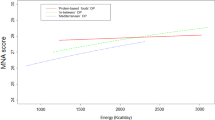Abstract
Objectives: To determine the patterns and possible explanations for gender differences in food choices, nutrient intakes and status indices, especially for micronutrients, in a representative sample of older people living in Britain, who participated in the National Diet and Nutrition Survey of people aged 65 y and over during 1994–95.
Design: The Survey procedures included a health-and-lifestyle interview, a four-day weighed diet record, anthropometric measurements and a fasting blood sample for biochemical indices.
Setting: Eighty randomly-selected postcode sectors from mainland Britain.
Subjects: Of 1556 older people not living in institutions who were interviewed, 80% agreed to provide a complete four-day diet record and 63% agreed to give a blood sample for status index measurements.
Interventions: None.
Main result: The most highly significant gender differences in food choices were that women ate more butter, full-fat milk and certain beverages, cakes, apples, pears and bananas, whereas men ate more eggs, sugar, certain meat products and drank more alcoholic drinks, especially beer and lager. When adjusted for energy intakes, the younger women (65–79 y) had higher intakes than the younger men, of fat, retinol, vitamin C and calcium. The older women (80+y) had higher intakes than older men, of fat and vitamin E, but lower intakes of protein, zinc and β-carotene. The younger women had better status indices than the younger men: for α- and β-carotenes, β-cryptoxanthin and vitamin C. Women had higher plasma concentrations of cholesterol and HDL cholesterol, phosphate and copper, but lower indices of iron and vitamin D status, than men. These gender differences in status were not altered by inclusion of the corresponding nutrient intakes in the model.
Conclusions: There are gender differences in food choices, in energy and nutrient intakes and in nutritional blood status indices in older British people, especially those aged 65–79 y. Some of the status differences are attenuated in the age group of 80 y and older, whereas others are enhanced. The relationships between the quantity and type of foods or nutrients consumed, and nutrient status, are complex. With respect to suspected risk and protective factors for vascular disease, women aged 65–79 y had significantly better status for plasma α-and β-carotene, ascorbate, HDL-cholesterol and homocysteine; but, in contrast, they had lower blood haemoglobin concentrations and higher concentrations of total and non-HDL-cholesterol.
Sponsorship: The British National Diet and Nutrition Survey series is funded by the Ministry of Agriculture, Fisheries and Food and the Department of Health, and this survey was conducted by Social and Community Planning Research in conjunction with MRC Human Nutrition Research (formerly MRC Dunn Nutritional Laboratory).
This is a preview of subscription content, access via your institution
Access options
Subscribe to this journal
Receive 12 print issues and online access
$259.00 per year
only $21.58 per issue
Buy this article
- Purchase on Springer Link
- Instant access to full article PDF
Prices may be subject to local taxes which are calculated during checkout
Similar content being viewed by others
Author information
Authors and Affiliations
Contributions
Guarantor: CJ Bates.
Contributorship: CJB, principal author; responsibility for biochemical analysis and data analysis; A Prentice, responsibility for the planning of our Laboratory’s role in the survey and contributions to the preparation of the manuscript; S Finch, responsibility for the survey field work, plus advice and assistance during preparation of the manuscript, responsibility for diet recording and data analysis and for the anthropometric measurements.
Corresponding author
Rights and permissions
About this article
Cite this article
Bates, C., Prentice, A. & Finch, S. Gender differences in food and nutrient intakes and status indices from the National Diet and Nutrition Survey of People Aged 65 Years and Over. Eur J Clin Nutr 53, 694–699 (1999). https://doi.org/10.1038/sj.ejcn.1600834
Received:
Revised:
Accepted:
Published:
Issue Date:
DOI: https://doi.org/10.1038/sj.ejcn.1600834
Keywords
This article is cited by
-
Sex differences in dietary consumption and its association with frailty among middle-aged and older Australians: a 10-year longitudinal survey
BMC Geriatrics (2021)
-
Dietary total antioxidant capacity significantly interacts with 6-P21 rs2010963 gene polymorphisms in terms of cardio-metabolic risk factors in patients with metabolic syndrome
BMC Research Notes (2020)
-
Differences in the association of diet quality with body fat distribution between men and women
European Journal of Clinical Nutrition (2020)
-
Chromium in Postmortem Material
Biological Trace Element Research (2018)
-
PIN1 genetic polymorphisms and the susceptibility of HBV-related hepatocellular carcinoma in a Guangxi population
Tumor Biology (2016)



